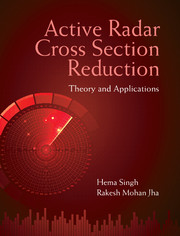Book contents
- Frontmatter
- Dedication
- Contents
- List of Tables
- List of Figures
- List of Abbreviations
- Preface
- Acknowledgements
- 1 Introduction to Radar Cross Section Reduction
- 2 RAM Analysis for Low-Observable Platforms
- 3 Radar Cross Section of Phased Antenna Arrays
- 4 Active RCS Reduction in Phased Arrays
- 5 Mutual Coupling Effects in Phased Arrays
- 6 RCS of Dipole Array Including Mutual Coupling Effects
- 7 Performance of Sidelobe Cancellers in Active RCSR
- 8 Emerging RCSR Techniques
- Epilogue
- Appendices
- List of Symbols
- Suggestions for Further Reading
- Author Index
- Subject Index
7 - Performance of Sidelobe Cancellers in Active RCSR
Published online by Cambridge University Press: 05 April 2015
- Frontmatter
- Dedication
- Contents
- List of Tables
- List of Figures
- List of Abbreviations
- Preface
- Acknowledgements
- 1 Introduction to Radar Cross Section Reduction
- 2 RAM Analysis for Low-Observable Platforms
- 3 Radar Cross Section of Phased Antenna Arrays
- 4 Active RCS Reduction in Phased Arrays
- 5 Mutual Coupling Effects in Phased Arrays
- 6 RCS of Dipole Array Including Mutual Coupling Effects
- 7 Performance of Sidelobe Cancellers in Active RCSR
- 8 Emerging RCSR Techniques
- Epilogue
- Appendices
- List of Symbols
- Suggestions for Further Reading
- Author Index
- Subject Index
Summary
Introduction
Optimum array processors find applications in diverse areas as versatile sensors. They are used in radar and communication systems that are subject to various types of interference and jamming. The sidelobe cancellers mainly perform the function of separating an unwanted signal from the desired signal to extract the relevant information from the signal while simultaneously reducing the noise power level. Various schemes of cancellers being proposed and implemented have better interference suppression capabilities and faster convergence (Li and Stoica 2005). This interference suppression capability of sidelobe cancellers can be used towards active radar cross section reduction (RCSR). Moreover, the application of an efficient adaptive algorithm like least mean square (LMS) in sidelobe cancellers can reduce the implementation complexity. In other words, sidelobe cancellers implementing an appropriate algorithm for weight optimisation can effectively suppress correlated and uncorrelated interfering signals. These interfering signals can be narrowband sources with single frequency, i.e. zero bandwidth or broadband sources distributed over a spectral band with some finite bandwidth.
Generalised sidelobe canceller (GSC) is especially useful when the information regarding the direction of arrival (DOA) of the interfering signal is not available a priori. The GSC is quite effective in reducing the computational burden when used with proper weight adaptation algorithms. The GSC employs linearly constrained minimum variance (LCMV) criterion to suppress the hostile sources incident from different directions but at the same time retains high output signal-to-interference noise ratio (SINR) towards the sources looking from desired directions. However, the performance of the GSC degrades considerably in case of discrepancy between the calculated and actual DOA (Figure 7.1). Moreover, the input signal of GSC is included in the stochastic gradient. Thus, the gradient becomes big and requires small step-size for weight adaptation for achieving converged solution.
This reduces the speed of convergence and, hence, the response of array towards the signal environment.
- Type
- Chapter
- Information
- Active Radar Cross Section ReductionTheory and Applications, pp. 245 - 267Publisher: Cambridge University PressPrint publication year: 2015



